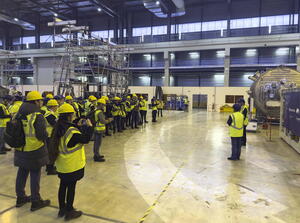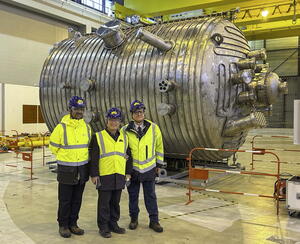Port plug test facility will operate in 2026
Russian-manufactured technology is behind a purpose-designed test bench that will verify that ITER port plugs respect all specifications before they are installed on the machine. A key piece of equipment arrived this week.
At a gathering on 17 November, stakeholders marked the arrival of the first vacuum test tank from Russia—a component that is crucial to beginning port plug testing in 2026.
“The first test bench of the ITER port plug test facility—with the vacuum test tank delivered today at its centre—is a tool that will allow us to test the 16 diagnostic port plugs that we need for the first operational phase at ITER,” said Victor Udintsev, who leads ITER’s Diagnostics Program. “We are expecting to learn a lot—how our planned processes work in reality, how sound our schedule is, and how reliably the test systems work.”
ITER’s port plug test facility will begin operating with one test bench before expanding in the coming years to three*, in order to handle the concurrent testing of port plugs housing not only diagnostics, but also heating, fuelling, and tritium test system components.
A port plug test bench is a complete system, with heating, vacuum, handling, and control systems all organized around the central vacuum tank. Once ITER port plugs are equipped with their tenant systems, they undergo a series of performance tests. One set of tests uses thermal cycling at high vacuum to measure the outgassing rates coming from the port plug assemblies and make sure the vacuum is protected as temperature and pressure are applied. Tests will also be performed to verify that the cooling circuits can handle both high pressure and pressure drops.
"Our job is to provide the testing facilities that can be used to make sure the port plugs stand up to the challenges they will find in the ITER reactor," says Olesya Solovyeva, director of the ITER project at Russian test stand manufacturer GKMP. "Very few applications have this combination of thermal cycling, high vacuum and nuclear requirements." (See a video produced by GKMP in Russian, with English subtitles, below.)
Ceremony guests on 17 November included Russian Consul General in Marseille Stanislav Oransky, Counsellor to the Russian Embassy Igor Noskov, Korean Domestic Agency Director Kijung Jung, Head of the ITER Construction Project Sergio Orlandi, Deputy Head of the Science Division Alexander Alekseev, as well as representatives from GKMP and Rosatom. A dozen members of the Russian media were on site to cover the ceremony.
“This test facility is one of the most complex and technologically advanced systems within our area of responsibility in the project,” said Anatoly Krasilnikov, head of ITER Russia. “For design and fabrication, our key suppliers had to develop and implement cutting-edge innovative solutions.”
Testing on the first port plug—upper port plug #4—will begin next year. “With the arrival of the first test vessel, we can say that we have received the first significant delivery in the scope of the diagnostics integration program,” Udintsev concluded.
*A fourth test stand is planned to be delivered to Fusion for Energy, the European Domestic Agency, for the testing of the port plugs under its responsibility.




